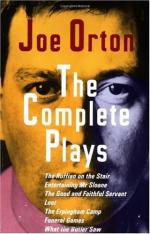|
This section contains 296 words (approx. 1 page at 400 words per page) |

|
What the Butler Saw Summary & Study Guide Description
What the Butler Saw Summary & Study Guide includes comprehensive information and analysis to help you understand the book. This study guide contains the following sections:
This detailed literature summary also contains Bibliography on What the Butler Saw by Joe Orton.
Joe Orton's What the Butler Saw was first performed on March 5, 1969, a year and a half after its author's death. Like Orton's earlier plays, What the Butler Saw appalled and enraged audiences with its blatant sexuality and attacks on authority and conventional morality. The first audiences were so outraged that they disturbed the performance, yelling at the actors and destroying their programs. In the ensuing years, society's standards have become less restrictive, though there are many who would still be shocked and angered by Orton's work. Orton, however, has gained international respect and recognition as an important playwright. Most critics regard What the Butler Saw as his finest play.
The title of the play comes from an Edwardian peepshow, a type of entertainment in which people viewed pictures, often erotic, through a small lens. The implication behind the title is one of voyeurism. The audience is to be given a glimpse of private sexual conduct. Orton's title indicates the sexual nature of the play and implies that the audience will be put in the position of voyeurs, surreptitiously watching other people's lives. The content of the play is frankly carnal, and sexuality and sexual identity are explored at length. What the Butler Saw also looks at authority, particularly at the authority of psychiatrists and considers the question of madness, of who is sane and who is insane.
What the Butler Saw is a comedy, more specifically the comedic subgenre known as a farce. Orton's themes, while serious, are intended to amuse. His witty dialogue is reminiscent of that of Victorian playwright Oscar Wilde (The Importance of Being Earnest). Like Wilde, Orton offers a criticism and exploration of society's standards. Entertaining as well as enlightening, What the Butler Saw is today considered a contemporary classic.
Read more from the Study Guide
|
This section contains 296 words (approx. 1 page at 400 words per page) |

|



